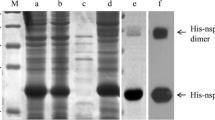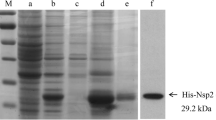Abstract
The M protein, encoded by the porcine reproductive and respiratory syndrome virus (PRRSV) ORF6 gene, is considered to be one of the most conserved PRRSV proteins. In recent decades, highly specific monoclonal antibodies (Mabs) have been exploited to provide reliable diagnoses for many diseases. In this study, two different Mab clones targeting the linear epitopes on the PRRSV M protein were generated and characterized. Both Mabs showed binding activity against the native PRRSV virion and recombinant M protein when analyzed by immunofluorescence assay (IFA) and Western blot. The targeted epitope of each Mab was mapped by serial truncation of the M protein to generate overlapping fragments. Fine epitope mapping was then performed using a panel of expressed polypeptides. The polypeptide sequences of the two epitopes recognized by Mabs 1C8 and 3F7 were 3SSLD6 and 155VLGGRKAVK163, respectively, with the former being a newly identified epitope on the M protein. In both cases, these two epitopes were finely mapped for the first time. Alignments of Mab epitope sequences revealed that the two epitopes on the M protein were highly conserved between the North American-type strains. These Mabs, along with their mapped epitopes, are useful for the development of diagnostic and research tools, including immunofluorescence, ELISA and Western blot.





Similar content being viewed by others
References
Benfield DA, Nelson E, Collins JE, Harris L, Goyal SM, Robison D, Christianson WT, Morrison RB, Gorcyca D, Chladek D (1992) Characterization of swine infertility and respiratory syndrome (SIRS) virus (isolate ATCC VR-2332). J Vet Diagn Invest 4:127–133
Cavanagh D (1997) Nidovirales: a new order comprising Coronaviridae and Arteriviridae. Arch Virol 142:629–633
Wensvoort G, Terpstra C, Pol JMA, ter Laak EA, Bloemraad M, de Kluyver EP, Kragten C, van Buiten L, den Besten A, Wagenaar F, Broekhuijsen JM, Moonen PLJM, Zetstra T, de Boer EA, Tibben HJ, de Jong MF, van’t Veld P, Groenland GJR, van Genep JA, Voets MT, Verheijden JHM, Braamskamp J (1991) Mystery swine disease in The Netherlands: the isolation of Lelystad virus. Vet Q 13:121–130
Dea S, Bilodeau R, Athanasious R, Sauvageau RA, Martineau GP (1992) PRRS syndrome in Quebec: isolation of a virus serologically related to Lelystad virus [letter]. Vet Rec 130:167
Garner MG, Whan IF, Gard GP, Phillips D (2001) The expected economic impact of selected exotic diseases on the pig industry of Australia. Rev Sci Technol 20(3):671–685
Neumann EJ, Kliebenstein JB, Johnson CD, Mabry JW, Bush EJ, Seitzinger AH, Green AL, Zimmerman JJ (2005) Assessment of the economic impact of porcine reproductive and respiratory syndrome on swine production in the United States. J Am Vet Med Assoc 227(3):385–392
Pejsak Z, Stadejek T, Markowska-Daniel I (1997) Clinical signs and economic losses caused by porcine reproductive and respiratory syndrome virus in a large breeding farm. Vet Microbiol 55(1–4):317–322
Albina E (1997) Epidemiology of porcine reproductive and respiratory syndrome (PRRS): an overview. Vet Microbiol 55:309–316
Hopper SA, White ME, Twiddy N (1992) An outbreak of blue-eared pig disease (porcine reproductive and respiratory syndrome) in four pig herds in Great Britain. Vet Rec 131:140–144
Rossow KD (1998) Porcine reproductive and respiratory syndrome. Vet Pathol 35:1–20
An TQ, Tian ZJ, Leng CL, Peng JM, Tong GZ (2011) Highly pathogenic porcine reproductive and respiratory syndrome virus, Asia. Emerg Infect Dis 17(9):1782–1784
An TQ, Tian ZJ, Xiao Y, Li R, Peng JM, Wei TC, Zhang Y, Zhou YJ, Tong GZ (2010) Origin of highly pathogenic porcine reproductive and respiratory syndrome virus, China. Emerg Infect Dis 16:365–367
Tian K, Yu X, Zhao T, Feng Y, Cao Z, Wang C, Hu Y, Chen X, Hu D, Tian X, Liu D, Zhang S, Deng X, Ding Y, Yang L, Zhang Y, Xiao H, Qiao M, Wang B, Hou L, Wang X, Yang X, Kang L, Sun M, Jin P, Wang S, Kitamura Y, Yan J, Gao GF (2007) Emergence of fatal PRRSV variants: unparalleled outbreaks of atypical PRRS in China and molecular dissection of the unique hallmark. PLoS One 2:e526
Tong GZ, Zhou YJ, Hao XF, Tian ZJ, An TQ, Qiu HJ (2007) Highly pathogenic porcine reproductive and respiratory syndrome, China. Emerg Infect Dis 13:1434–1436
Meulenberg JJ, Hulst MM, de Meijer EJ, Moonen PL, den Besten A, de Kluyver EP, Wensvoort G, Moormann RJ (1993) Lelystad virus, the causative agent of porcine epidemic abortion and respiratory syndrome (PEARS), is related to LDV and EAV. Virology 192:62–72
Mardassi H, Mounir S, Dea S (1995) Molecular analysis of the ORFs 3 to 7 of porcine reproductive and respiratory syndrome virus, Quebec reference strain. Arch Virol 140:1405–1418
Mardassi H, Mounir S, Dea S (1995) Structural gene analysis of a Quebec reference strain or porcine reproductive and respiratory syndrome virus (PRRSV). Adv Exp Med Biol 380:277–281
Faaberg KS, Even C, Palmer GA, Plagemann PG (1995) Disulfide bonds between two envelope proteins of lactate dehydrogenase-elevating virus are essential for viral infectivity. J Virol 69:613–617
Mardassi H, Massie B, Dea S (1996) Intracellular synthesis, processing, and transport of proteins encoded by ORFs 5 to 7 of porcine reproductive and respiratory syndrome virus. Virology 221:98–112
Delputte PL, Vanderheijden N, Nauwynck HJ, Pensaert MB (2002) Involvement of the matrix protein in attachment of porcine reproductive and respiratory syndrome virus to a heparinlike receptor on porcine alveolar macrophages. J Virol 76:4312–4320
Snijder EJ, Dobbe JC, Spaan WJ (2003) Heterodimerization of the two major envelope proteins is essential for arterivirus infectivity. J Virol 77:97–104
Jiang W, Jiang P, Li Y, Tang J, Wang X, Ma S (2006) Recombinant adenovirus expressing GP5 and M fusion proteins of porcine reproductive and respiratory syndrome virus induce both humoral and cell-mediated immune responses in mice. Vet Immunol Immunopathol 113:169–180
Bautista EM, Faaberg KS, Mickelson D, McGruder ED (2002) Functional properties of the predicted helicase of porcine reproductive and respiratory syndrome virus. Virology 298:258–270
de Lima M, Pattnaik AK, Flores EF, Osorio FA (2006) Serologic marker candidates identified among B-cell linear epitopes of Nsp2 and structural proteins of a North American strain of porcine reproductive and respiratory syndrome virus. Virology 353:410–421
Tian ZJ, An TQ, Zhou YJ, Peng JM, Hu SP, Wei TC, Jiang YF, Xiao Y, Tong GZ (2009) An attenuated live vaccine based on highly pathogenic porcine reproductive and respiratory syndrome virus (HP-PRRSV) protects piglets against HP-PRRS. Vet Microbiol 138(1–2):34–40
Zhou YJ, Hao XF, Tian ZJ, Tong GZ, Yoo D, Zhou T, Li GX, Qiu HJ, Wei TC, Yuan XF (2008) Highly virulent porcine reproductive and respiratory syndrome virus emerged in China. Transbound Emerg Dis 55(3–4):152–164
Leng CL, An TQ, Chen JZ, Gong DQ, Peng JM, Yang YQ, Wu J, Guo JJ, Li DY, Zhang Y, Meng ZX, Wu YQ, Tian ZJ, Tong GZ (2012) Highly pathogenic porcine reproductive and respiratory syndrome virus GP5 B antigenic region is not a neutralizing antigenic region. Vet Microbiol 159(3):273–281
Plagemann PG, Rowland RR, Faaberg KS (2002) The primary neutralization epitope of porcine respiratory and reproductive syndrome virus strain VR-2332 is located in the middle of the GP5 ectodomain. Arch Virol 147:2327–2347
Cancel-Tirado SM, Evans RB, Yoon KJ (2004) Monoclonal antibody analysis of porcine reproductive and respiratory syndrome virus epitopes associated with antibody-dependent enhancement and neutralization of virus infection. Vet Immunol Immunopathol 102:249–262
Ostrowski M, Galeota JA, Jar AM, Platt KB, Osorio FA, Lopez OJ (2002) Identification of neutralizing and nonneutralizing epitopes in the porcine reproductive and respiratory syndrome virus GP5 ectodomain. J Virol 76:4241–4250
Plagemann PG (2005) Epitope specificity of monoclonal antibodies to the N-protein of porcine reproductive and respiratory syndrome virus determined by ELISA with synthetic peptides. Vet Immunol Immunopathol 104:59–68
Yan YL, Guo X, Ge XN, Chen YH, Cha ZL, Yang HC (2007) Monoclonal antibody and porcine antisera recognized B-cell epitopes of Nsp2 protein of a Chinese strain of porcine reproductive and respiratory syndrome virus. Virus Res 126:207–215
Song YH, Zhou YF, Li YF, Wang XM, Bai J, Cao J, Jiang P (2012) Identification of B-cell epitopes in the NSP1 protein of porcine reproductive and respiratory syndrome virus. Vet Microbiol 155:220–229
Acknowledgments
This study was supported by the Heilongjiang Natural Science Funds for Distinguished Young Scholars (JC201314), the National Natural Science Foundation of China (grant no. 31001050) and the National High Technology Research and Development Program (863 plan) (Grant No. 2011AA10A208).
Author information
Authors and Affiliations
Corresponding authors
Rights and permissions
About this article
Cite this article
Wang, Q., Chen, J., Peng, J. et al. Characterisation of novel linear antigen epitopes on North American-type porcine reproductive and respiratory syndrome virus M protein. Arch Virol 159, 3021–3028 (2014). https://doi.org/10.1007/s00705-014-2174-4
Received:
Accepted:
Published:
Issue Date:
DOI: https://doi.org/10.1007/s00705-014-2174-4




